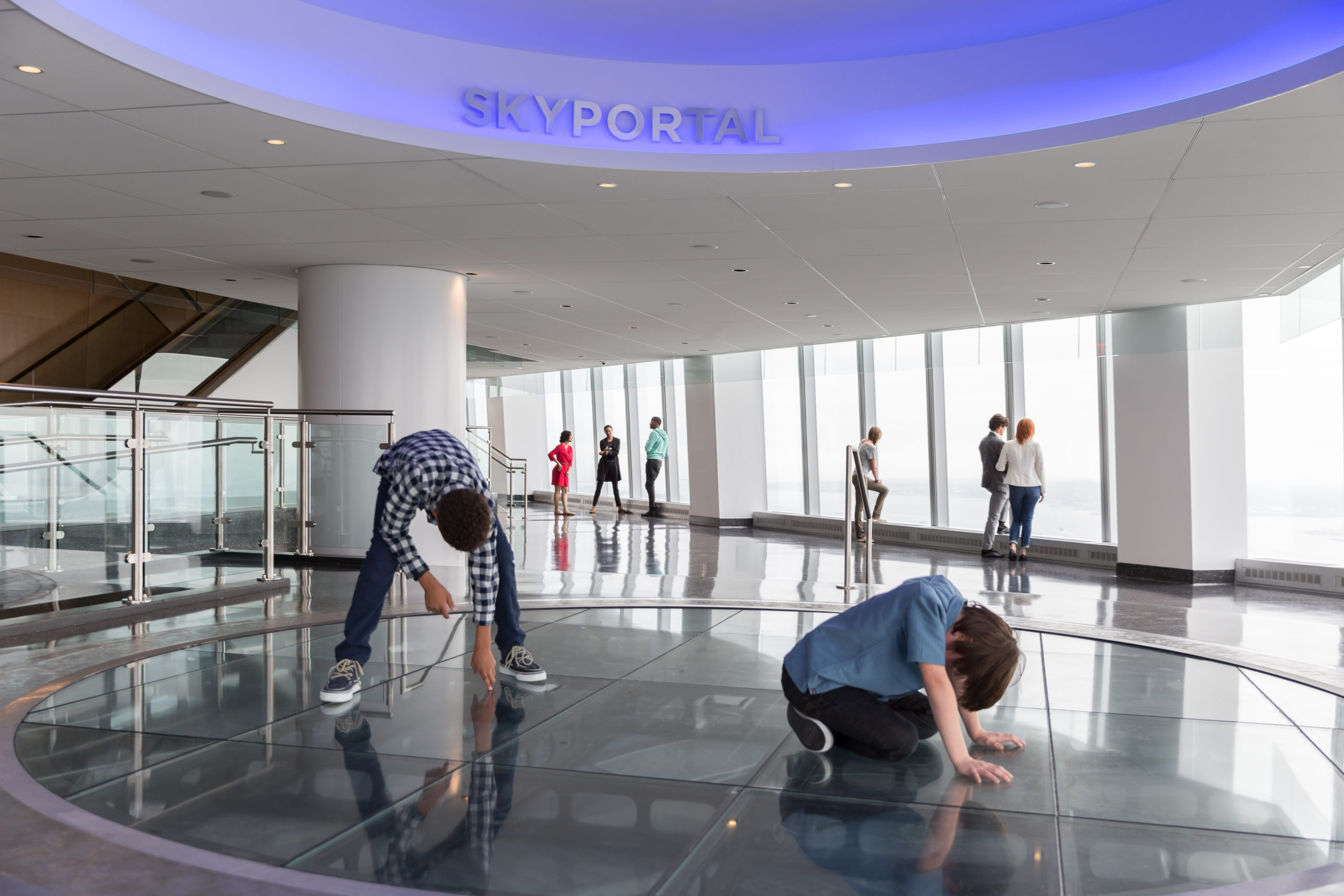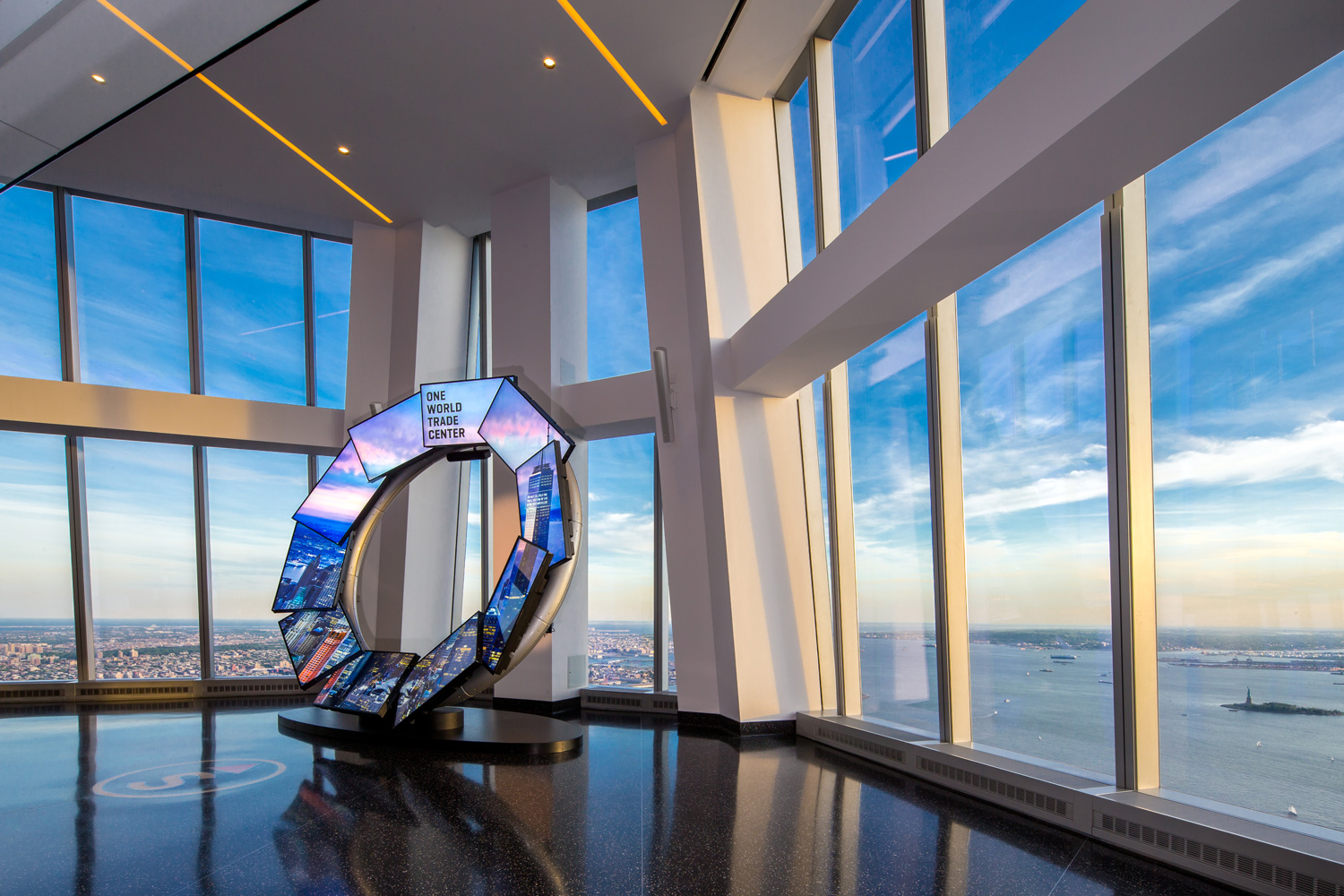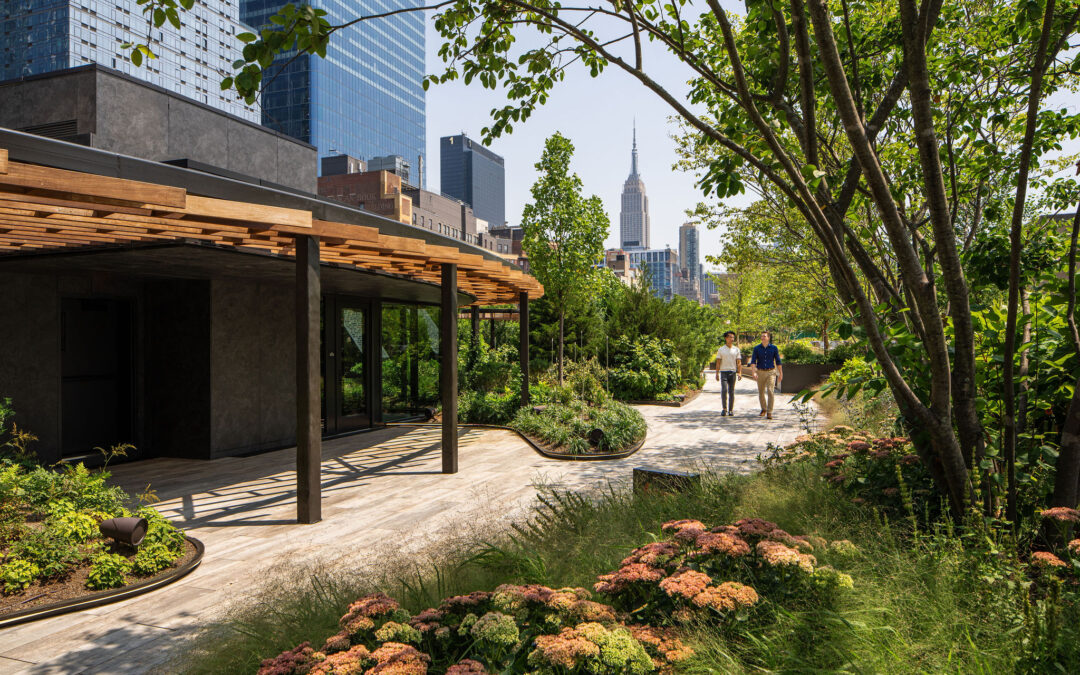After Spreading Globally for Decades, Observation Decks Experience a Rebirth in New York
At Edge in New York’s Hudson Yards on a recent Friday afternoon, hundreds of visitors packed the highest outdoor sky deck in the Western Hemisphere, jutting out in midair, to soak in views of the city and capture images for sharing on social media. A glass floor allows thrill-seeking visitors to look 100 stories down.
Just steps away, two young men, in a span of about 20 minutes, each proposed to their girlfriends at the same spot, against the backdrop of the iconic Empire State Building less than a mile away.
Corbin Duncan, 24, got down on one knee with a group of siblings and friends by his side. On his first visit to New York, the Superior, Wisconsin, resident said the idea of popping the question in the midst of the skyline appealed to him: “This is the prettiest view of Manhattan,” Duncan said, adding he would still like to check out other new observation decks in New York if he returns to the city.
Ninety years after the Empire State Building proved there’s mass appeal in a sky-high observatory as a tourist attraction, the concept has since been replicated globally, from Canada to the United Arab Emirates, as tall buildings have become symbols of cities, even countries. Now deck fervor is seeing a resurgence in New York, with a new emphasis on experiences and multidimensional vantage points, as buildings rely more on tourism revenue as parts of some office towers go unused in the pandemic.
Edge’s 2020 opening at 30 Hudson Yards was followed across town by the October debut of Summit, a multilevel observatory in the crown of the 1,401-foot-tall One Vanderbilt tower in midtown Manhattan. There’s also a plan for a new observation deck at the historic Chrysler Building to add to an existing ensemble that includes Top of the Rock at Rockefeller Center and One World Observatory, the deck at the 1,776-foot-tall One World Trade Center, the tallest skyscraper in the Western Hemisphere.
Edge launched a curiosity described as the world’s highest external building climb — an activity for daring individuals who want to hang over the side of the building suspended by a harness 1,271 feet in the air.
“If I have time, I would go to all of them because they all offer something different,” Daniel Safarik, assistant director of research and thought leadership at the Council on Tall Buildings and Urban Habitat, said in an interview. “It’s about what you can see from that building and what’s the experience from that. New York has been the skyscraper capital in the world for longer than everywhere else. A building in lower Manhattan is going to [offer] a totally different experience from the one in midtown. You get to appreciate different frames of reference.”
There is a potential downside to the added decks. While the pandemic is curtailing some office usage in buildings, it also is curbing tourism and attendance, so more observation decks in New York means more competition for fewer potential visitors.
Global Heights
With the rise of soaring towers outside the United States, the tall building council’s data shows none of the top 15 tallest observation decks in the world are in New York. Willis Tower in Chicago is the only one from the United States on the list. Many of the loftier decks are in China and other Asian countries, as well as the Middle East.
“Overseas is where the action is” when it comes to the absolute height, Safarik said. “It’s about a country or a city announcing itself on the world stage. It’s also about power projection.”
Still, New York, where the Empire State Building stood as the world’s tallest building for nearly 40 years, has the distinction of having the most observatories in recognizable buildings, according to Safarik.
“The idea of the skyscraper as the ultimate symbol of a dynamic city really was invented in New York and Chicago,” James Sanders, an architect and author of the book “Celluloid Skyline,” told CoStar News. The building of tall towers in cities overseas often “responds to the old idea of what makes [a city] modern. For so many people, skyscrapers remain the symbol of a modern city. Their image of what it means to show the world that you are a dynamic, modern city is to have a tall tower. It’s about pride and prestige. Those towers are saying, ‘We can build buildings as tall. We have come on the scene.’ It has to do with national pride. [It’s not about] ‘Does it make commercial sense?’”
In New York, on the other hand, what makes the city hip and modern is no longer its skyscrapers but spots such as restaurants or “cool workspaces,” said Sanders, who’s working on an exhibit project on global observation decks.
What also often sets New York observatories apart is the city’s towers-heavy skyline that makes the views “three dimensional” in contrast to many of the decks outside the United States that look out at essentially flat landscapes, Sanders said.
“Globally, as technology has gotten better, buildings are able to be erected even taller,” Richard DeMarco, principal of Montroy DeMarco Architecture, the executive architect behind a new redesign project for Top of the Rock and an upgrade for One World Observatory, said in an interview. “The deck that’s the tallest becomes advertising. It sets the mark. The notion of power of the world’s tallest building is something you can trumpet around the world. That’s the type of decks that are out there [overseas]. It’s the building that dwarfs the surroundings in the city. You are looking at the city as if you are on the plane.”
Financial Support
There’s little doubt that what’s driving New York’s resurgent deck scene is its potential to be a big tourist draw, creating significant financial contributors to buildings. That has become even more relevant amid the uncertainty surrounding the negative impact of the remote working trend in the office sector brought on by the COVID-19 pandemic.
Take the Empire State Building, for example. When the deck at the art deco tower opened in 1931 during the Great Depression, it had 1 million visitors annually within a couple of years, according to Sanders.
Fast forward to today, the observatory remains crucial. Before the coronavirus upended New York’s travel sector and limited tourist flow, the deck, which completed a $160 million overhaul in 2019, generated record January and February 2020 revenue, according to a regulatory filing from its owner, Empire State Realty Trust.
In fact, the number of visitors to the Empire State Building observatories, located on the tower’s 86th and 102nd floors, totaled 3.5 million in 2019, with more than 60% of visitors from overseas. Before COVID-19, the decks generated nearly $129 million in 2019 revenue, equating about two-fifths of total building revenue that year and representing about 18% of the total revenue generated by Empire State Realty Trust, whose office and retail portfolio covers 10.1 million rentable square feet in the New York metro area as of June 30.
“This is a cash business versus a lease with a tenant in it,” DeMarco said.
In another example, private equity firm KKR recently bought a majority stake in Edge at Hudson Yards, the largest U.S. private development, on the west side of Manhattan.
Luring Tourism Revenue
Marc Holliday, CEO of One Vanderbilt developer SL Green Realty, Manhattan’s largest office landlord, said on Oct. 21 he has “big expectations” that Summit will be a “hit” and benefit the real estate investment trust and its shareholders “tremendously.” The feature has mirrors on three sides spanning two levels that create a kaleidoscope of images against the sweeping views of the skyline outside.
“We spent years in design, taking the best elements of observation decks, cultural institutions, experiential art and immersive technology, and combined it all into Summit,” Holliday said on a conference call with Wall Street analysts. “The result is an experience that has the potential to not only become one of the most sought-after destinations in New York City, but a true global phenomenon.”
It’s not just the decks in New York that are major tourist draws. Burj Khalifa in Dubai, United Arab Emirates, the world’s tallest tower, and Taiwan’s Taipei 101, the tallest building in the world when it opened in 2004 before it was surpassed by Burj Khalifa in 2010, are often listed among their respective regions’ top destinations for visitors.
For instance, the deck at Taipei 101, which the tall building council said represents a worldwide precedent for sustainable skyscraper development and is known for its New Year’s Eve fireworks display, features not only 360-degree views of Taipei. The observatory pitches 4D multimedia interactive and other immersive experiences and has the world’s largest steel ball wind damper, weighing 728 tons, on public display. The ball acts as a pendulum to counter the building’s vibrations.
Burj Khalifa, which the tall building council describes as a “global icon” at a height of 2,717 feet, opened a second sky deck on level 148 in October 2014 after its original At the Top deck on level 124 launched in 2010. In a move common among global decks seeking to sell a memorable experience, At the Top in June relaunched a sunrise package that comes with morning treats and beverages — a perk the Empire State Building’s observatory also offers.
Canada’s CN Tower, ranked by the tall building council as the 10th-tallest observatory, features a revolving restaurant. For thrill-seekers, it offers EdgeWalk, an experience that comes with a “certificate of achievement” at the end alongside a keepsake video and printed photos. EdgeWalk is billed as the world’s highest full-circle, hands-free walk on a 5-foot-wide ledge encircling the top of the building’s main pod 1,168 feet, or 116 stories, above the ground. Guests are secured by a harness, and there is no railing.
The 1,844-foot tall deck at Ping An Finance Center tower in China’s Shenzhen is ranked as the tallest observatory globally, followed by the one at Shanghai Tower, according to the tall building council.
Attendance Concerns
Enthusiasm for new or renovated decks aside, it remains to be seen in New York whether tourists and local visitors will return or show up to justify increased deck supply. Despite improvement year over year, visits at the Empire State Building observatory were only about 30% of the 2019 level through late July, according to Empire State Realty Trust. CEO Anthony Malkin has said he doesn’t expect attendance to recover until the end of 2022.
The REIT has also cautioned in a regulatory filing that competition from decks such as Edge and Summit may “divert visitors” and “negatively impact” its revenue. To up its game amid increased competition, Empire State Observatory’s renovation, completed in 2019, included adding a 10,000-square-foot “tactile and digital immersive museum experience” on the second floor to showcase the building’s history and place in pop culture. The installation of floor-to-ceiling glass windows allowed unobstructed views on the 102nd floor.
And the competition isn’t just coming from other decks.
“They have a lot of other entertainment to compete with” such as Broadway shows, the tall building council’s Safarik said. These decks “are like little amusement parks [that offer] all types of sensory experiences. They are all trying to outdo each other. It’s not just about the skyline. It’s also about ‘We got the most interesting experience.’ They are all competing for the entertainment dollars. It’s against ‘What am I going to do with my afternoon?’”
For existing decks seeking to vie against new projects, upgrades also make sense.
“You have to work out the bottom line so the investment” can pay off, DeMarco said. For instance, it makes sense to redesign both Top of the Rock and One World Observatory because they both are near other attractions such as the skating rink and shops by Rockefeller Center and the 9/11 Memorial and Museum by One World Trade Center, he said.
That becomes “a natural feeder” for the nearby observation deck, DeMarco said. “The city has millions of people who visit each year. People come back every couple of years. There’s demand.”
For David Zamarripa, who was on vacation for his first visit to New York from Grand Island, Nebraska, it was a no-brainer to come up to the deck of what’s touted as “the world’s most famous building.”
“When you think of New York City, you think of the Empire State Building automatically,” Zamarripa said. “I thought, ‘How can I experience New York without experiencing the Empire State Building?’ It feels special because it’s original architecture. It’s so full of history people just have to come here. You can’t beat the views.”
Source: CoStar Magazine / By Andria Cheng and Jelena Schulz



NYREJ’S 2024 Ones to Watch Industry Leaders: Job Captain, Mateusz Slapinski
New York Real Estate 2024 Ones to Watch Industry Leaders Spotlight: Mateusz Slapinski, Job Captain, Montroy DeMarco Architecture “Mat is one of the impressive young leaders within our firm’s architecture and interior design studios. He leads his projects with...

Morgan North’s Architectural Design Team Honored at NYCxDesign 2024 Awards Ceremony
The Architectural Design Team for Morgan North was honored at the NYCxDESIGN 2024 Awards ceremony. The redevelopment and adaptive reuse of the Morgan North Post Office was recognized for its outstanding architectural planning, interior design, and landscape...

The Redevelopment of the Historic USPS Morgan North Receives 2024 Project Profile Award by Commercial Construction & Renovation (CCR) Magazine
Morgan North, New York, New York Designer: Montroy DeMarco Architecture LLP, Shimoda Design Group, HMWhite (Landscape Architect) Contractor: Urban Atelier Group The expansive, 645,000 SF Morgan North redevelopment by Tishman Speyer transforms what was once New...
